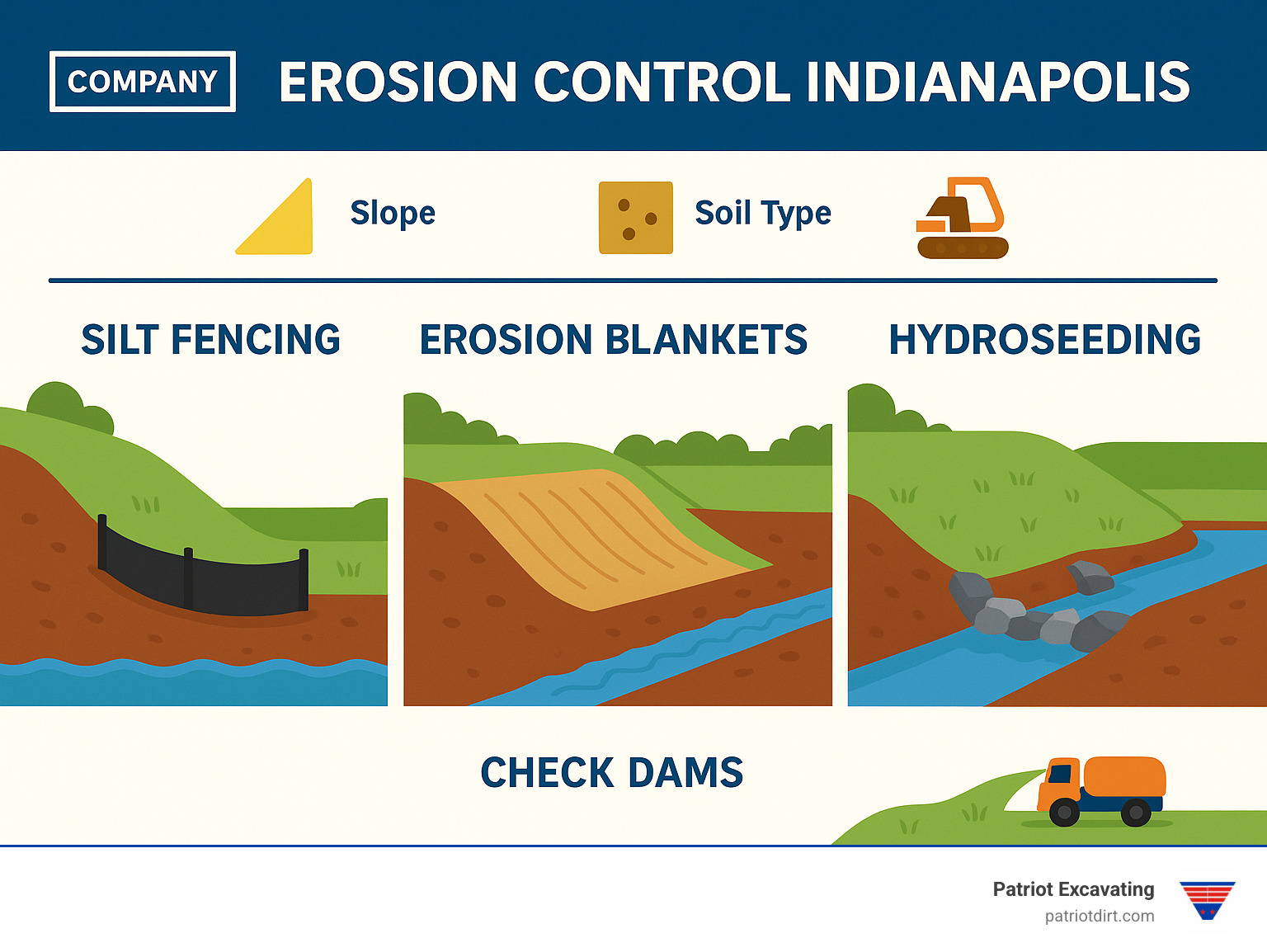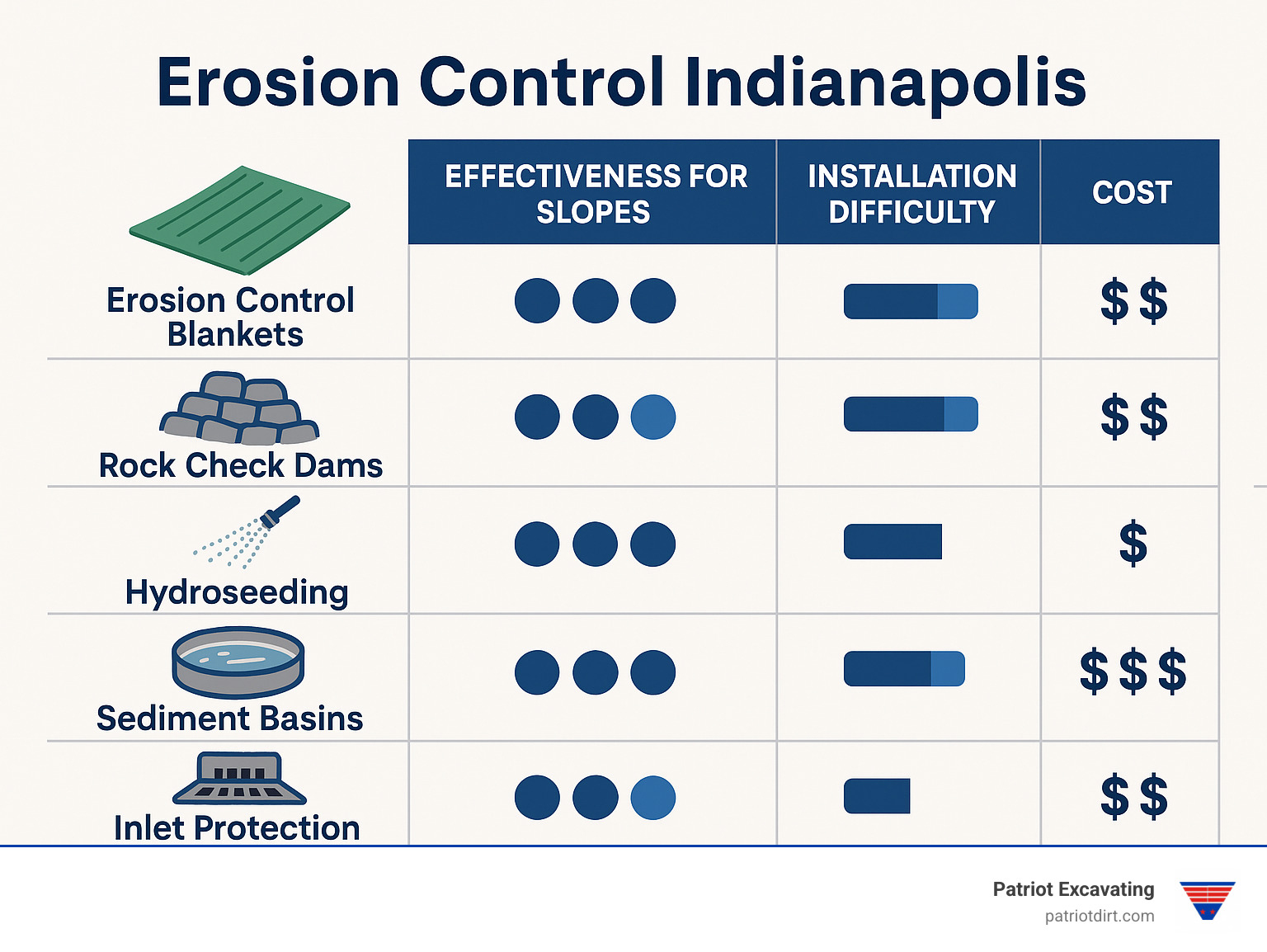Protecting Indianapolis Properties from Erosion Damage
Erosion control Indianapolis services focus on preventing soil loss and water damage on construction sites and properties throughout central Indiana. When searching for reliable erosion management solutions in Indianapolis, here’s what you should know:
- Most Common Causes: Heavy rainfall, construction activities, poor drainage, and Indianapolis’ clay-heavy soils
- Popular Solutions: Silt fencing, erosion control blankets, hydroseeding, check dams, and detention basins
- Local Requirements: Projects disturbing 1+ acre require NPDES permits and SWPPP plans
- Best Practices: Install perimeter controls before breaking ground and stabilize exposed soil within 14 days
Soil erosion represents one of the most significant threats to Indianapolis construction projects and residential properties alike. Without proper controls, sediment runoff can damage waterways, destabilize foundations, and lead to costly regulatory violations and project delays.
The unique soil composition and weather patterns of central Indiana create specific erosion challenges that require targeted solutions. Heavy spring rainfall combined with freeze-thaw cycles and our region’s clay loam soils make professional erosion management essential for project success.
I’m Clay Hamilton PE, President of Patriot Excavating with over two decades of hands-on experience implementing effective erosion control Indianapolis solutions that protect both your investment and our local environment. Contact us today for a site assessment custom to your specific property conditions.

Choosing the Right Erosion Control Indianapolis Solutions
When it comes to protecting your Indianapolis property or construction site from erosion, selecting the appropriate control measures is crucial. At Patriot Excavating, we understand that every site presents unique challenges based on its specific characteristics.
The key to effective erosion control Indianapolis strategies lies in matching solutions to your site’s particular conditions. Several factors influence this decision:
- Soil type – Indianapolis’ predominantly clay loam soils require specific approaches
- Slope length and steepness – Steeper slopes need more robust protection
- Expected rainfall intensity – Central Indiana’s seasonal precipitation patterns
- Duration of soil exposure – Short-term construction vs. long-term stabilization
- Proximity to sensitive areas – Waterways, wetlands, or residential neighborhoods
“The most expensive erosion control solution is the one that fails,” explains our lead project manager. “We focus on getting it right the first time by thoroughly assessing each site’s unique needs before implementation.”
Main Causes of Soil Loss in Central Indiana
Central Indiana’s landscape presents several natural and human-induced factors that contribute to soil erosion:
- Glacial till soils – Our region’s soil composition was formed by glacial activity, creating a mix of clay, silt, and sand that can be highly erodible when disturbed
- Clay loam texture – While clay soils can resist erosion when undisturbed, once exposed during construction, they become vulnerable to both water and wind erosion
- Heavy spring rains – Indianapolis typically receives significant rainfall in spring months, with intense storms that can quickly overwhelm inadequate erosion controls
- Freeze-thaw cycles – Our winters create soil expansion and contraction that loosens soil particles
- Construction grading – Site development that removes vegetation and disrupts natural contours
- Channelized runoff – Concentrated water flow from impervious surfaces like roofs, roads, and parking lots
One recent project in Fishers demonstrated how quickly erosion can occur. After just one 2-inch rainfall event, a site without proper controls lost nearly 4 tons of soil per acre. With our properly designed and installed erosion control system, a neighboring site with similar characteristics experienced minimal soil loss during the same storm.
Most Effective BMPs for Erosion Control Indianapolis
Based on our extensive experience throughout central Indiana, we’ve identified several Best Management Practices (BMPs) that consistently deliver superior results:
- Erosion Control Blankets – These biodegradable mats protect freshly graded slopes by absorbing rainfall impact and holding soil in place until vegetation establishes. They’re particularly effective on the moderate slopes common in Indianapolis subdivisions.
- Rock Check Dams – Strategically placed in drainage channels and swales, these stone structures slow water velocity and trap sediment. We’ve found them especially effective when combined with other measures in Carmel and Noblesville developments.
- Hydroseeding – This technique applies a slurry of seed, mulch, fertilizer, and binding agents to quickly establish vegetation. It’s ideal for large areas in Greenwood and Franklin where rapid stabilization is needed.
- Sediment Basins – For larger sites in Avon and Plainfield, these engineered depressions capture runoff and allow sediment to settle before water is discharged.
- Inlet Protection – Critical in urban settings like downtown Indianapolis, these devices prevent sediment from entering storm drains and ultimately reaching waterways.
For more comprehensive information about managing water on your property, visit our stormwater solutions page.
Materials & Products Roundup
At Patriot Excavating, we use a variety of high-quality materials to ensure effective erosion control Indianapolis implementation:

- Geotextiles – These permeable fabrics separate, filter, reinforce, and protect soil layers. We use them extensively under rip rap and in trench drains throughout Fishers and Carmel projects.
- Turf Reinforcement Mats (TRMs) – For areas with higher flow velocities in Noblesville and Westfield, these permanent non-degradable mats provide long-term erosion protection while supporting vegetation growth.
- Fiber Rolls/Straw Wattles – These tubular products slow runoff velocity and capture sediment on slopes. They’re particularly effective on residential developments in Brownsburg and Avon.
- Rip Rap – Various sizes of stone used to stabilize slopes, shorelines, and areas with concentrated water flow. Our teams regularly install this at outfall structures in Greenwood and Franklin.
- Silt Fencing – A perimeter control that intercepts and filters sediment-laden runoff before it leaves the site. Learn more about our silt fencing installation techniques.
- Compost Socks – Tubular mesh filled with compost that filters runoff while adding organic matter to the soil. We’ve had great success with these in environmentally sensitive areas in Martinsville and Mooresville.

Planning, Installation & Maintenance Guide
Successful erosion control Indianapolis projects require careful planning, proper installation, and diligent maintenance. At Patriot Excavating, we follow a comprehensive approach to ensure maximum effectiveness and regulatory compliance.
Regulatory & Permitting Insights
Understanding and navigating the regulatory landscape is essential for any construction project in central Indiana:
- Indiana Rule 5 – This regulation applies to all land-disturbing activities of one acre or more, requiring a permit and implementation of erosion and sediment control measures.
- NPDES Permits – The National Pollutant Discharge Elimination System requires construction site operators to obtain coverage for discharging stormwater from their sites.
- SWPPP Requirements – A Storm Water Pollution Prevention Plan must be developed and implemented, detailing all BMPs to be used on site.
- Inspection Logs – Regular site inspections must be documented, typically weekly and after rainfall events of 0.5 inches or more.
- Local MS4 Ordinances – Many municipalities in the Indianapolis area have additional requirements beyond state regulations.
“Navigating the permitting process can be overwhelming,” notes our compliance specialist. “At Patriot Excavating, we handle all aspects of regulatory compliance, from initial permit applications through final stabilization and Notice of Termination.”
For additional industry insights, the Indiana Constructors stormwater page provides valuable resources.
Step-by-Step Site Implementation
Our proven implementation process ensures effective erosion control and regulatory compliance:
- Pre-disturbance assessment and staking – Before breaking ground, we evaluate existing conditions and mark the limits of disturbance and locations for BMPs.
- Perimeter controls first – We install silt fence, fiber rolls, or other perimeter controls before any major soil disturbance begins.
- Phased implementation – When possible, we disturb only portions of the site at a time to minimize exposed soil.
- Slope interruption measures – On longer slopes, we install intermediate controls to break up the flow length and reduce runoff velocity.
- Stabilization within 14 days – In accordance with regulations, we ensure that areas where construction activities have temporarily or permanently ceased are stabilized within 14 days.
- Construction entrances – We install and maintain stabilized construction entrances to prevent tracking sediment onto public roads.
For more information about our site preparation services, check out our article on Land Grading vs. Land Leveling.
Post-Installation Monitoring & Vegetation
The work doesn’t end once erosion controls are in place. Proper maintenance is critical for long-term effectiveness:
- Weekly inspections – Our team conducts regular site evaluations to identify and address any issues with erosion control measures.
- Rainfall event checks – After significant precipitation, we perform additional inspections to ensure all systems are functioning properly.
- Sediment removal – When sediment accumulates to one-third the height of a control measure, we remove and properly dispose of it.
- Re-seeding bare spots – Areas where vegetation hasn’t established are promptly addressed to maintain continuous cover.
- Long-term vegetative planning – We select appropriate plant species for permanent stabilization based on soil conditions, sun exposure, and maintenance requirements.
A recent project in Carmel demonstrated the importance of proper monitoring. After identifying areas where initial seeding was struggling to establish, we quickly implemented supplemental measures, preventing potential erosion issues and avoiding regulatory citations.
Learn more about how proper drainage relates to erosion control in our article on The Crucial Role of Proper Drainage: Safeguarding Your Property Against Erosion and Damage.
Conclusion & Next Steps
Finding the right erosion control Indianapolis partner shouldn’t be complicated. At Patriot Excavating, we’ve spent over twenty years getting to know every hill, slope, and soil type in central Indiana. Our family-owned team brings that local expertise to every project we touch – from sprawling subdivisions in Greenwood to commercial developments in Carmel and residential properties in Noblesville.
What makes our approach different is how seamlessly we integrate erosion control with our other services. Rather than treating erosion management as an afterthought, we weave it into our comprehensive site preparation process alongside excavation, grading, and utility work. This gives you one point of contact instead of juggling multiple contractors, and ensures all aspects of your site work in harmony.
“The Indianapolis area presents unique challenges with our clay-heavy soils and unpredictable rainfall patterns,” explains our field supervisor. “We’ve developed techniques specifically for these conditions that simply work better than one-size-fits-all approaches.”
I’ve personally seen how proper erosion control can save headaches, time, and significant money. On a recent Fishers development, our preventative measures helped the client avoid costly mid-project corrections and kept them on schedule despite an unusually wet spring.
Whether you’re developing a multi-acre commercial site in Plainfield or dealing with drainage issues on your Mooresville property, we bring the same attention to detail and regional knowledge to every project. Our team understands not just how to install erosion controls, but why specific solutions work best in particular situations throughout central Indiana.
Ready to protect your investment and the environment? Contact our team today at (317) 555-1234 for a thorough site assessment and customized erosion control plan custom to your specific property conditions. We’ll walk you through exactly what your site needs without unnecessary complications or technical jargon.
For property owners concerned about water management beyond erosion control, our drainage services page offers additional solutions that complement erosion prevention measures.
Trust Patriot Excavating for all your erosion control Indianapolis needs – because when it comes to protecting both your property and our local waterways, experience in your specific region makes all the difference.



